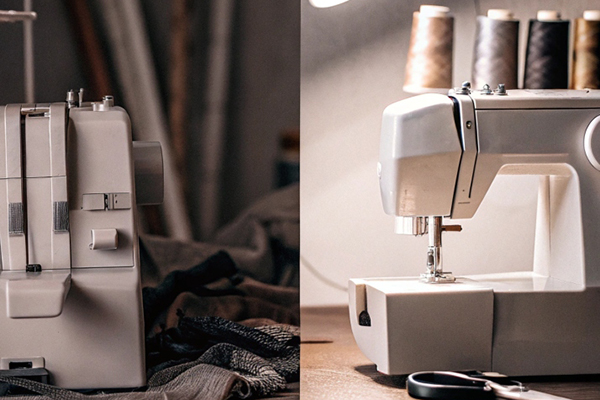When it comes to sewing, creating professional finishes often requires more than just a basic sewing machine. Terms like "overlock" and "serger" are frequently used, but they can be confusing, especially for beginners. Are they the same thing, or do they serve different purposes?
The main difference between an overlock and a serger lies in terminology and functionality. In most cases, the terms are interchangeable, with "serger" being commonly used in North America and "overlock" being the preferred term in Europe and other parts of the world.1
This article explains the differences (and similarities) between overlock machines and sergers, their uses, and whether they can replace traditional sewing machines.
Can a Serger Do Everything a Sewing Machine Can Do?
Sewing machines and sergers are both essential tools for sewing enthusiasts, but they serve different purposes.
No, a serger cannot do everything a sewing machine can do.2 While it excels at finishing edges and creating stretchable seams, a serger cannot perform basic sewing tasks like creating buttonholes, topstitching, or working on intricate designs.

Key Differences Between a Sewing Machine and a Serger
-
Primary Function
- Sewing Machine:
Designed for versatile tasks (straight stitches, buttonholes, decorative work). - Serger:
Specializes in trimming seam allowances, finishing edges, and creating professional seams.
- Sewing Machine:
-
Thread Usage
- Sewing Machine:
Typically uses one or two threads. - Serger:
Uses three to five threads for robust, stretchable seams.
- Sewing Machine:
-
Fabric Finishing
- Sewing Machine:
Leaves raw edges that may need separate finishing. - Serger:
Automatically trims and seals edges, preventing fraying.
- Sewing Machine:
| Feature | Sewing Machine | Serger |
|---|---|---|
| Stitch Options | Multiple, decorative included | Limited to overlocking and similar tasks |
| Fabric Trimming | No | Yes, trims seam allowances |
| Edge Finishing | Requires extra steps | Built-in functionality |
| Thread Count | 1-2 | 3-5 |
When to Use a Serger:
- Stretch Fabrics: Ideal for knits, athletic wear.
- Professional Finishes: Perfect for fray-resistant edges.
- High-Volume Projects: Speeds up sewing with simultaneous trimming and stitching.
What Are the Functions of an Overlock Machine?
An overlock machine (serger) focuses on tasks a regular sewing machine can’t achieve as efficiently.
Overlock machines sew seams, trim excess fabric, and finish raw edges in one go, resulting in durable, professional-quality finishes.3

Core Functions
- Edge Finishing: Prevents fraying by encasing raw edges.
- Seam Creation: Sews and finishes seams simultaneously.
- Stretch Seams: Handles elastic fabrics effortlessly.
- Rolled Hems: Creates delicate hems on lightweight fabrics.
- Decorative Edging: Adds decorative stitches for special projects.
Limitations
- Cannot sew buttonholes or zippers.
- Not ideal for intricate detail work like quilting or embroidery.
- Best for straight seams, not tight curves.
| Function | Description |
|---|---|
| Edge Finishing | Prevents fraying, neat edges |
| Stretch Seams | Flexible, durable seams for knits |
| Rolled Hems | Clean, delicate hems |
| Decorative Stitches | Unique edging for home décor/projects |
Choosing the Right Machine for Your Needs
Should You Buy a Serger or Sewing Machine First?
If you’re starting out, a sewing machine is your best first investment—more versatile for foundational skills.
- When to Add a Serger:
Consider a serger once you regularly sew garments or need professional finishing on stretch fabrics.
Do You Need Both?
Owning both machines expands your sewing capabilities.
- Complementary Roles:
Sewing machine handles zippers, buttonholes, decorative stitches; serger excels at finishing seams and handling stretchy fabrics.
Factors to Consider
- Budget: Sergers often cost more than basic sewing machines.
- Skill Level: Sergers have a steeper learning curve (thread tension, etc.).
- Project Type: Determine if seam finishing or stretch fabrics are a priority.
| Criteria | Sewing Machine | Serger |
|---|---|---|
| Versatility | All-purpose stitching | Specialized in seam finishing |
| Cost | Lower entry-level cost | Higher initial investment |
| Learning Curve | Beginner-friendly | Intermediate skill required |

Innovations in Overlock and Serger Machines
Modern advancements make these machines user-friendly and versatile.
- Automatic Threading: Eases one of the biggest challenges—threading multiple threads.
- Differential Feed: Adjusts fabric feed to prevent puckering or stretching.4
- Combined Machines: Some offer sewing and serging features in one device.
- Decorative Options: More stitch types for adding unique finishes.
Conclusion
"Overlock" and "serger" often refer to the same type of machine, differing mainly in regional terminology. While a serger can’t replace a sewing machine’s versatility, it’s invaluable for achieving professional finishes, working with stretch fabrics, and streamlining seam finishing.
For beginners, starting with a sewing machine is wise. As your skills grow, investing in a serger can take your projects to a more professional level. With user-friendly features and technological advancements, sergers are an excellent addition to any sewing enthusiast’s toolkit.













